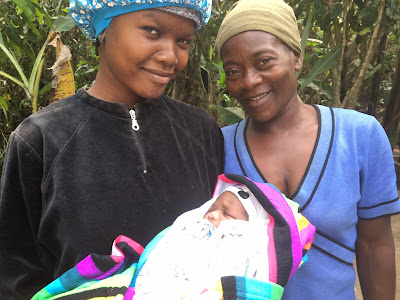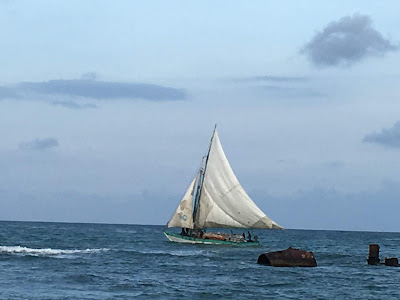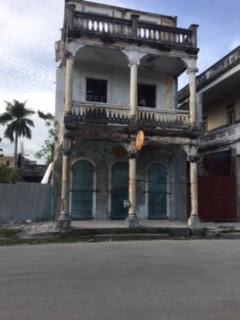
 |
|
Lavi Se Dwol ," Life is funny," is one of the thousands of phrases seen painted on the colorful trucks that crawl over the impossible roads of Haiti. This one stuck out for me, because unlike the usual appeal to Jesus to spare the driver, this admitted to the ridiculous roulette of existence here. Rereading Graham Greene's The Comedians, he too endorsed a sense of humor in this land some 55 years ago. This "beautiful and bedeviled country," he wrote," is a dark blend of terror and farce."
It wasn’t quite what we intended, to walk 26 miles over the mountains behind Port-au-Prince to Jacmel alone. We meant to bring curious friends of HHP for a funky donor tour over the backbone of Haiti, reaching an elevation of 5000 feet, then a descent to the sea on the other side. But due to the chaos here over the past year - frequent protests involving huge crowd manifestations, tire burning roadblocks, flying bullets fighting the corrupt government - our friends opted to try it another time when the situation is a bit more placid. We understand, lavi se dwol.
 |
| Kay Ronald's garden |
Optimistic nonetheless, we figured we needed to try out the path ourselves if we were ever going to bring along paying guests. Peter Halle, Hispañola Health Partner’s board president, Dr. Daniel Antoine, our resident doctor in our clinic in SE Haiti, and I agreed to this journey together. We started in Kenskoff, a region above Petionville, at the crest of the peak from which all of Port-au-Prince pours downward.
We stayed our first night at Kay Ronald, (see Airbnb addresses below) a lovely and fascinating architectural whimsy that twists around the terrain of the mountaintop, created by Haitian architect Ronald Blain. We took off after a breakfast of herring and eggs…..up the hill further by motorcycle. We walked a gentle ascent for a few miles in the midmorning sun, but with the unfortunate burden of 20-pound backpacks (we were going to be in transit for 5 days), we realized we would need a little assistance.
 |
| The Haitian Alps |
 We climbed and sweated, straddled motorcycles and slid in the mud and rocks along the Haitian national route 101. No truck or car could ever traverse these narrow peaks, we left them behind in Kenskoff. We felt humbled by people walking along with us who do this every day with burdens much heavier than ours on their heads and backs, I also sympathized with the donkeys, who occupy the lowest rung of the hauling hierarchy.
We climbed and sweated, straddled motorcycles and slid in the mud and rocks along the Haitian national route 101. No truck or car could ever traverse these narrow peaks, we left them behind in Kenskoff. We felt humbled by people walking along with us who do this every day with burdens much heavier than ours on their heads and backs, I also sympathized with the donkeys, who occupy the lowest rung of the hauling hierarchy.
 |
| Don't Wanna Be Your Beast of Burden |
We staggered to the top of Tet Kay Jak, the highest altitude on the national highway and then continued on for a few blessedly flat kilometers through Parc National La Visite. One of two national parks in Haiti, it is covered with Hispaniolan Pine, and is so cool and misty you need a jacket in mid-afternoon. We arrived at Kay Winny in time for a big thermos of mint tea. Unoccupied for 7 months because of the national crisis, we were the first guests to open a new chapter for the place. This is rugged tourism at its best, I thought, as I wrapped my weary muscles in a duvet. The candlelight cradled me after a goat stew dinner and a warm beer.
 |
| Kay Winny |
A rapid descent the next morning to the sea on Haiti's southern side by foot and moto, then fast forward to our arrival by skiff to Belle Anse where I was meeting our supervising nurse for Ede Tèt Nou, our female cancer program. We were scheduled to see a few women who had been treated for positive HPV (precancer of the cervix) and needed follow up. This program screens and treats 1600 women in the rural and remote Arrondissement de Belle Anse for breast and cervical cancer.
 |
| Training session for Ede Tèt Nou for community health workers at our health center |
 |
| On the beach in Belle Anse |
Crumbling, hot and slightly decadent is Belle Anse, a great place for a stranger to gently perish of solitude. The sound of the relentless surf heaves a billion loose stones at every sigh. On the beach, trudging through drifts of slippery stones, my sole companion amidst the piles of plastic bottles mixed with seaweed and the resident swine, is a ten-year-old boy who watches me stumble, mockingly. Life here is not easy but neither is death. I knew a fellow whose coffin split in two while banging in the waves in the boat that was bringing him to his proper funeral miles down the coast.
 |
| The "Jel" |
As I lie inside the balcony of the Jel Hotel, I wonder if anyone should feel compelled to advance this place, or is it better to leave it to decay respectfully without outside tampering?
As a wild, endangered specimen of postcolonial Caribbean life, hard looks of manual labor is on every face, child to crone. Muscles of the arms and backs peek through clothing while I watch the beach-launching of boats, the hauling of 5-foot bags of charcoal, the shoveling of stone and sand. This prototype of the working man has been virtually lost in other Caribbean nations, replaced by the soft labor of tourism. At least this place belongs to them.
When I eventually got to our clinic in Marjofre (CSUG), I arrived on time to help usher this baby into the world. Will he know a better Haiti or is misery as imprinted here as his DNA?
 |
| born yesterday |
 |
| open wide |
HHP/CSUG has just entered into a new chapter with the hiring of a skilled birth attendant and the drawing of plans to develop the second story of the clinic into a birth center and residence for staff. This will move us into a 24-hour care center. Thanks to the generosity of our donors, we were able to provide 3 days of dental care to the community for a modest price of $1.62/visit. This was the first time in 3 years that dental care has been accessible to our population.
It's kanaval time in Haiti but the president called off celebrations in Port-au-Prince for the threat of violence. Yet here in our gentle corner of the country, we enjoyed some traditional music and dance with our neighbors. They remember you, the people who give their support from so far away, on this day of grace and simple beauty. We thank you deeply, Louise
Please visit us and donate at: Hispañola Health Partners
 |
| Twobadou music |
Calibrian dance and song, Marjofre
Kay Ronald https://www.airbnb.com/rooms/18395646.
Kay Winny https://www.airbnb.com/rooms/25476515












































